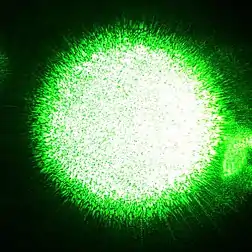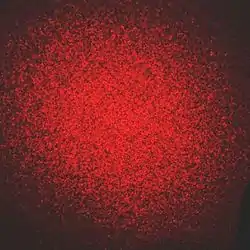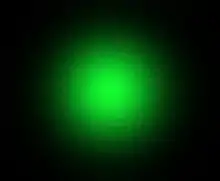Speckle pattern
A speckle pattern is produced by the mutual interference of a set of coherent wavefronts.[1][2] Although this phenomenon has been investigated by scientists since the time of Newton, speckles have come into prominence since the invention of the laser. They have been used in a variety of applications in microscopy,[3][4] imaging,[5][6] and optical manipulation.[7][8][9]
Speckle patterns typically occur in diffuse reflections of monochromatic light such as laser light. Such reflections may occur on materials such as paper, white paint, rough surfaces, or in media with a large number of scattering particles in space, such as airborne dust or in cloudy liquids.[10]
The term speckle pattern is also commonly used in the experimental mechanics community to describe the pattern of physical speckles on a surface[11][12] which is useful for measuring displacement fields via digital image correlation.
Explanation
The speckle effect is a result of the interference of many waves of the same frequency, having different phases and amplitudes, which add together to give a resultant wave whose amplitude, and therefore intensity, varies randomly. If each wave is modeled by a vector, then it can be seen that if a number of vectors with random angles are added together, the length of the resulting vector can be anything from zero to the sum of the individual vector lengths—a 2-dimensional random walk, sometimes known as a drunkard's walk. In the limit of many interfering waves the distribution of intensities (which go as the square of the vector's length) becomes exponential , where is the mean intensity.[1][2][13][14]
When a surface is illuminated by a light wave, according to diffraction theory, each point on an illuminated surface acts as a source of secondary spherical waves. The light at any point in the scattered light field is made up of waves which have been scattered from each point on the illuminated surface. If the surface is rough enough to create path-length differences exceeding one wavelength, giving rise to phase changes greater than 2π, the amplitude, and hence the intensity, of the resultant light varies randomly.
If light of low coherence (i.e., made up of many wavelengths) is used, a speckle pattern will not normally be observed, because the speckle patterns produced by individual wavelengths have different dimensions and will normally average one another out. However, speckle patterns can be observed in polychromatic light in some conditions.[15]
Subjective speckles

When a rough surface which is illuminated by a coherent light (e.g. a laser beam) is imaged, a speckle pattern is observed in the image plane; this is called a "subjective speckle pattern" – see image above. It is called "subjective" because the detailed structure of the speckle pattern depends on the viewing system parameters; for instance, if the size of the lens aperture changes, the size of the speckles change. If the position of the imaging system is altered, the pattern will gradually change and will eventually be unrelated to the original speckle pattern.
This can be explained as follows. Each point in the image can be considered to be illuminated by a finite area in the object. The size of this area is determined by the diffraction-limited resolution of the lens which is given by the Airy disk whose diameter is 2.4λu/D, where λ is the wavelength of the light, u is the distance between the object and the lens, and D is the diameter of the lens aperture. (This is a simplified model of diffraction-limited imaging.)
The light at neighboring points in the image has been scattered from areas which have many points in common and the intensity of two such points will not differ much. However, two points in the image which are illuminated by areas in the object which are separated by the diameter of the Airy disk, have light intensities which are unrelated. This corresponds to a distance in the image of 2.4λv/D where v is the distance between the lens and the image. Thus, the "size" of the speckles in the image is of this order.
The change in speckle size with lens aperture can be observed by looking at a laser spot on a wall directly, and then through a very small hole. The speckles will be seen to increase significantly in size. Also, the speckle pattern itself will change when moving the position of the eye while keeping the laser pointer steady. A further proof that the speckle pattern is formed only in the image plane (in the specific case the eye's retina) is that the speckles will stay visible if the eye's focus is shifted away from the wall (this is different for an objective speckle pattern, where the speckle visibility is lost under defocussing).
Objective speckles

When laser light which has been scattered off a rough surface falls on another surface, it forms an "objective speckle pattern". If a photographic plate or another 2-D optical sensor is located within the scattered light field without a lens, a speckle pattern is obtained whose characteristics depend on the geometry of the system and the wavelength of the laser. The speckle pattern in the figure was obtained by pointing a laser beam at the surface of a mobile phone so that the scattered light fell onto an adjacent wall. A photograph was then taken of the speckle pattern formed on the wall. Strictly speaking, this also has a second subjective speckle pattern but its dimensions are much smaller than the objective pattern so it is not seen in the image.
The light at a given point in the speckle pattern is made up of contributions from the whole of the scattering surface. The relative phases of these scattered waves vary across the scattering surface, so that the resulting phase on each point of the second surface varies randomly. The pattern is the same regardless of how it is imaged, just as if it were a painted pattern.
The "size" of the speckles is a function of the wavelength of the light, the size of the laser beam which illuminates the first surface, and the distance between this surface and the surface where the speckle pattern is formed. This is the case because when the angle of scattering changes such that the relative path difference between light scattered from the centre of the illuminated area compared with light scattered from the edge of the illuminated changes by λ, the intensity becomes uncorrelated. Dainty[1] derives an expression for the mean speckle size as λz/L where L is the width of the illuminated area and z is the distance between the object and the location of the speckle pattern.
Near-field speckles
Objective speckles are usually obtained in the far field (also called Fraunhofer region, that is the zone where Fraunhofer diffraction happens). This means that they are generated "far" from the object that emits or scatters light. Speckles can be observed also close to the scattering object, in the near field (also called Fresnel region, that is, the region where Fresnel diffraction happens). This kind of speckles are called near-field speckles. See near and far field for a more rigorous definition of "near" and "far".
The statistical properties of a far-field speckle pattern (i.e., the speckle form and dimension) depend on the form and dimension of the region hit by laser light. By contrast, a very interesting feature of near field speckles is that their statistical properties are closely related to the form and structure of the scattering object: objects that scatter at high angles generate small near field speckles, and vice versa. Under Rayleigh–Gans condition, in particular, speckle dimension mirrors the average dimension of the scattering objects, while, in general, the statistical properties of near field speckles generated by a sample depend on the light scattering distribution.[16][17]
Actually, the condition under which the near field speckles appear has been described as more strict than the usual Fresnel condition.[18]
Optical vortices in speckle patterns
Speckle interference pattern may be decomposed in the sum of plane waves. There exist a set of points where amplitude of electromagnetic field is exactly zero. These points had been recognized as dislocations of wave trains .[19] These phase dislocations of electromagnetic field are known as optical vortices.
There is a circular energy flow around each vortex core. Thus each vortex in the speckle pattern carries optical angular momentum. The angular momentum density is given by:[20]
Typically vortices appear in speckle pattern in pairs. These vortex - antivortex pairs are placed randomly in space. One may show that electromagnetic angular momentum of each vortex pair is close to zero.[21] In phase conjugating mirrors based on stimulated Brillouin scattering optical vortices excite acoustical vortices.[22]
Apart from formal decomposition in Fourier series the speckle pattern may be composed for plane waves emitted by tilted regions of the phase plate. This approach significantly simplifies numerical modelling. 3D numerical emulation demonstrates the intertwining of vortices which leads to formation of ropes in optical speckle.[23]
Applications
When lasers were first invented, the speckle effect was considered to be a severe drawback in using lasers to illuminate objects, particularly in holographic imaging because of the grainy image produced. It was later realized that speckle patterns could carry information about the object's surface deformations, and this effect is exploited in holographic interferometry and electronic speckle pattern interferometry. The speckle effect is also used in speckle imaging and in eye testing using speckle.
Speckle is the chief limitation of coherent lidar and coherent imaging in optical heterodyne detection.
In the case of near field speckles, the statistical properties depend on the light scattering distribution of a given sample. This allows the use of near field speckle analysis to detect the scattering distribution; this is the so-called near-field scattering technique.[24]
When the speckle pattern changes in time, due to changes in the illuminated surface, the phenomenon is known as dynamic speckle, and it can be used to measure activity, by means of, for example, an optical flow sensor (optical computer mouse). In biological materials, the phenomenon is known as biospeckle.
In a static environment, changes in speckle can also be used as a sensitive probe of the light source. This can be used in a wavemeter configuration, with a resolution around 1 attometre,[25] (equivalent to 1 part in 1012 of the wavelength, equivalent to measuring the length of a football field at the resolution of a single atom[26]) and can also stabilise the wavelength of lasers[27] or measure polarization.[28]
The disordered pattern produced by speckle has been used in quantum simulations with cold atoms. The randomly-distributed regions of bright and dark light act as an analog of disorder in solid-state systems, and are used to investigate localization phenomena.[29]
In fluorescence microscopy, a sub-diffraction-limited resolution can be obtained in 2D from saturable/photoconvertible pattern illumination techniques like stimulated emission depletion (STED) microscopy, ground state depletion (GSD) microscopy, and reversible saturable optical fluorescence transitions (RESOLFT). Adapting speckle patterns for use in these applications enables parallel 3D super-resolution imaging.[30]
Reduction

Speckle is considered to be a problem in laser based display systems like the Laser TV. Speckle is usually quantified by the speckle contrast. Speckle contrast reduction is essentially the creation of many independent speckle patterns, so that they average out on the retina/detector. This can be achieved by,[31]
- Angle diversity: illumination from different angles
- Polarization diversity: use of different polarization states
- Wavelength diversity: use of laser sources which differ in wavelength by a small amount
Rotating diffusers—which destroys the spatial coherence of the laser light—can also be used to reduce the speckle. Moving/vibrating screens or fibers may also be solutions.[32] The Mitsubishi Laser TV appears to use such a screen which requires special care according to their product manual. A more detailed discussion on laser speckle reduction can be found here.[33]
Synthetic array heterodyne detection was developed to reduce speckle noise in coherent optical imaging and coherent differential absorption LIDAR.
In scientific applications, a spatial filter can be used to reduce speckle.
Analogies
Speckle-like patterns can also be observed in other systems where random interference occurs, including situations where, for example, the phenomenon is not observed over space but in time. This is the case of phase sensitive optical time-domain reflectometry, where multiple reflections of a coherent pulse generated at different instants interfere to produce a random time-domain signal.[34]
See also
References
- Dainty, C., ed. (1984). Laser Speckle and Related Phenomena (2nd ed.). Springer-Verlag. ISBN 978-0-387-13169-6.
- Goodman, J. W. (1976). "Some fundamental properties of speckle". JOSA. 66 (11): 1145–1150. doi:10.1364/josa.66.001145.
- Ventalon, Cathie; Mertz, Jerome (2006-08-07). "Dynamic speckle illumination microscopy with translated versus randomized speckle patterns". Optics Express. 14 (16): 7198. doi:10.1364/oe.14.007198. ISSN 1094-4087. PMID 19529088.
- Pascucci, M.; Ganesan, S.; Tripathi, A.; Katz, O.; Emiliani, V.; Guillon, M. (2019-03-22). "Compressive three-dimensional super-resolution microscopy with speckle-saturated fluorescence excitation". Nature Communications. 10 (1): 1–8. doi:10.1038/s41467-019-09297-5. ISSN 2041-1723.
- Katz, Ori; Bromberg, Yaron; Silberberg, Yaron (2009-09-28). "Compressive ghost imaging". Applied Physics Letters. 95 (13): 131110. arXiv:0905.0321. Bibcode:2009ApPhL..95m1110K. doi:10.1063/1.3238296. ISSN 0003-6951.
- Dunn, Andrew K.; Bolay, Hayrunnisa; Moskowitz, Michael A.; Boas, David A. (2001-03-01). "Dynamic Imaging of Cerebral Blood Flow Using Laser Speckle". Journal of Cerebral Blood Flow & Metabolism. 21 (3): 195–201. doi:10.1097/00004647-200103000-00002. ISSN 0271-678X.
- Bechinger, Clemens; Di Leonardo, Roberto; Löwen, Hartmut; Reichhardt, Charles; Volpe, Giorgio; Volpe, Giovanni (2016-11-23). "Active Particles in Complex and Crowded Environments". Reviews of Modern Physics. 88 (4). Bibcode:2016RvMP...88d5006B. doi:10.1103/revmodphys.88.045006. hdl:11693/36533. ISSN 0034-6861.
- Volpe, Giorgio; Volpe, Giovanni; Gigan, Sylvain (2014-02-05). "Brownian Motion in a Speckle Light Field: Tunable Anomalous Diffusion and Selective Optical Manipulation". Scientific Reports. 4 (1): 3936. doi:10.1038/srep03936. ISSN 2045-2322. PMC 3913929. PMID 24496461.
- Volpe, Giorgio; Kurz, Lisa; Callegari, Agnese; Volpe, Giovanni; Gigan, Sylvain (2014-07-28). "Speckle optical tweezers: micromanipulation with random light fields". Optics Express. 22 (15): 18159–18167. doi:10.1364/OE.22.018159. hdl:11693/12625. ISSN 1094-4087. PMID 25089434.
- Mandel, Savannah (2019-11-14). "Creating and controlling non-Rayleigh speckles". Scilight. 2019 (46): 461111. doi:10.1063/10.0000279.
- Hua, Tao; Xie, Huimin; Wang, Simon; Hu, Zhenxing; Chen, Pengwan; Zhang, Qingming (2011). "Evaluation of the quality of a speckle pattern in the digital image correlation method by mean subset fluctuation". Optics & Laser Technology. 43 (1): 9–13. Bibcode:2011OptLT..43....9H. doi:10.1016/j.optlastec.2010.04.010.
- Lecompte, D.; Smits, A.; Bossuyt, Sven; Sol, H.; Vantomme, J.; Hemelrijck, D. Van; Habraken, A.M. (2006). "Quality assessment of speckle patterns for digital image correlation". Optics and Lasers in Engineering. 44 (11): 1132–1145. Bibcode:2006OptLE..44.1132L. doi:10.1016/j.optlaseng.2005.10.004.
- Bender, Nicholas; Yılmaz, Hasan; Bromberg, Yaron; Cao, Hui (2019-11-01). "Creating and controlling complex light". APL Photonics. 4 (11): 110806. doi:10.1063/1.5132960.
- Bender, Nicholas; Yılmaz, Hasan; Bromberg, Yaron; Cao, Hui (2018-05-20). "Customizing speckle intensity statistics". Optica. 5 (5): 595–600. arXiv:1711.11128. doi:10.1364/OPTICA.5.000595. ISSN 2334-2536.
- McKechnie, T.S. (1976). "Image-plane speckle in partially coherent illumination". Optical and Quantum Electronics. 8: 61–67. doi:10.1007/bf00620441.
- Giglio, M.; Carpineti, M.; Vailati, A. (2000). "Space Intensity Correlations in the Near Field of the Scattered Light: A Direct Measurement of the Density Correlation Function g(r)". Physical Review Letters. 85 (7): 1416–1419. Bibcode:2000PhRvL..85.1416G. doi:10.1103/PhysRevLett.85.1416. PMID 10970518.
- Giglio, M.; Carpineti, M.; Vailati, A.; Brogioli, D. (2001). "Near-Field Intensity Correlations of Scattered Light". Applied Optics. 40 (24): 4036–40. Bibcode:2001ApOpt..40.4036G. doi:10.1364/AO.40.004036. PMID 18360438.
- Cerbino, R. (2007). "Correlations of light in the deep Fresnel region: An extended Van Cittert and Zernike theorem" (PDF). Physical Review A. 75 (5): 053815. Bibcode:2007PhRvA..75e3815C. doi:10.1103/PhysRevA.75.053815.
- Nye, J. F.; Berry, M. V. (1974). "Dislocations in Wave Trains". Proceedings of the Royal Society A. 336 (1605): 165–190. Bibcode:1974RSPSA.336..165N. doi:10.1098/rspa.1974.0012.
- Optical Angular Momentum
- Okulov, A. Yu. (2008). "Optical and sound helical structures in a Mandelstam-Brillouin mirror". JETP Letters. 88 (8): 487–491. Bibcode:2008JETPL..88..487O. doi:10.1134/S0021364008200046.
- Okulov, A Yu (2008). "Angular momentum of photons and phase conjugation". Journal of Physics B. 41 (10): 101001. arXiv:0801.2675. Bibcode:2008JPhB...41j1001O. doi:10.1088/0953-4075/41/10/101001.
- Okulov, A. Yu (2009). "Twisted speckle entities inside wave-front reversal mirrors". Physical Review A. 80 (1): 013837. arXiv:0903.0057. Bibcode:2009PhRvA..80a3837O. doi:10.1103/PhysRevA.80.013837.
- Brogioli, D.; Vailati, A.; Giglio, M. (2002). "Heterodyne near-field scattering". Applied Physics Letters. 81 (22): 4109–11. arXiv:physics/0305102. Bibcode:2002ApPhL..81.4109B. doi:10.1063/1.1524702.
- Bruce, Graham D.; O’Donnell, Laura; Chen, Mingzhou; Dholakia, Kishan (2019-03-15). "Overcoming the speckle correlation limit to achieve a fiber wavemeter with attometer resolution". Optics Letters. 44 (6): 1367. arXiv:1909.00666. doi:10.1364/OL.44.001367. ISSN 0146-9592.
- Tudhope, Christine (7 March 2019). "New research could revolutionise fiber-optic communications". Phys.org. Retrieved 2019-03-08.
- Metzger, Nikolaus Klaus; Spesyvtsev, Roman; Bruce, Graham D.; Miller, Bill; Maker, Gareth T.; Malcolm, Graeme; Mazilu, Michael; Dholakia, Kishan (2017-06-05). "Harnessing speckle for a sub-femtometre resolved broadband wavemeter and laser stabilization". Nature Communications. 8: 15610. arXiv:1706.02378. Bibcode:2017NatCo...815610M. doi:10.1038/ncomms15610. PMC 5465361. PMID 28580938.
- Facchin, Morgan; Bruce, Graham D.; Dholakia, Kishan; Dholakia, Kishan; Dholakia, Kishan (2020-05-15). "Speckle-based determination of the polarisation state of single and multiple laser beams". OSA Continuum. 3 (5): 1302–1313. doi:10.1364/OSAC.394117. ISSN 2578-7519.
- Billy, Juliette; Josse, Vincent; Zuo, Zhanchun; Bernard, Alain; Hambrecht, Ben; Lugan, Pierre; Clément, David; Sanchez-Palencia, Laurent; Bouyer, Philippe (2008-06-12). "Direct observation of Anderson localization of matter waves in a controlled disorder". Nature. 453 (7197): 891–894. arXiv:0804.1621. Bibcode:2008Natur.453..891B. doi:10.1038/nature07000. ISSN 0028-0836. PMID 18548065.
- Bender, Nicholas; Sun, Mengyuan; Yılmaz, Hasan; Bewersdorf, Joerg; Bewersdorf, Joerg; Cao, Hui (2021-02-20). "Circumventing the optical diffraction limit with customized speckles". Optica. 8 (2): 122–129. doi:10.1364/OPTICA.411007. ISSN 2334-2536.
- Trisnadi, Jahja I. (2002). "Speckle contrast reduction in laser projection displays". Projection Displays VIII. 4657. pp. 131–137. doi:10.1117/12.463781.
- "Despeckler". Fiberguide. Retrieved 24 May 2019.
- Chellappan, Kishore V.; Erden, Erdem; Urey, Hakan (2010). "Laser-based displays: A review". Applied Optics. 49 (25): F79–98. Bibcode:2010ApOpt..49F..79C. doi:10.1364/ao.49.000f79. PMID 20820205.
- Garcia-Ruiz, Andres (2016). "Speckle Analysis Method for Distributed Detection of Temperature Gradients With Φ OTDR". IEEE Photonics Technology Letters. 28 (18): 2000. Bibcode:2016IPTL...28.2000G. doi:10.1109/LPT.2016.2578043.
External links
- Seeing speckle in your fingernail
- Research group on light scattering and photonic materials
- Brogioli, Doriano; Vailati, Alberto; Giglio, Marzio (2009). "Near Field Speckles". arXiv:0907.3376 [physics.optics].
